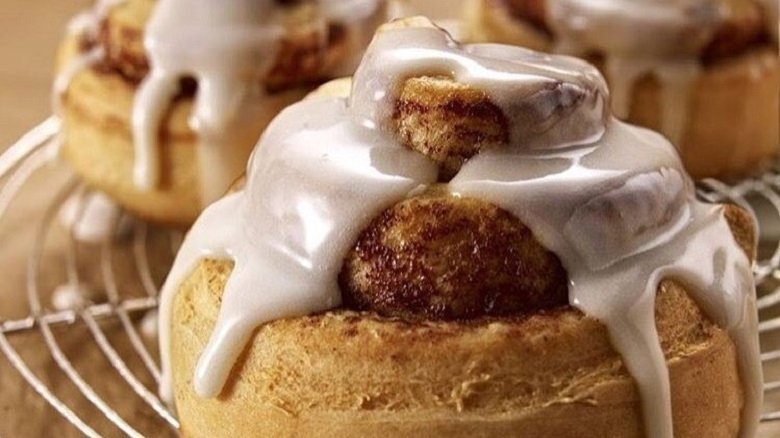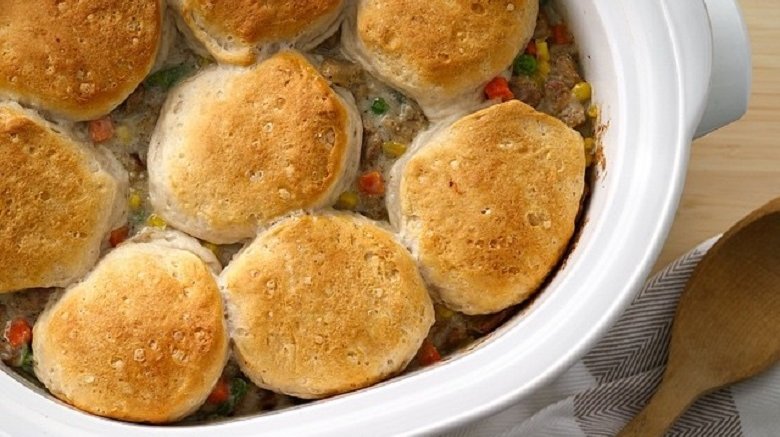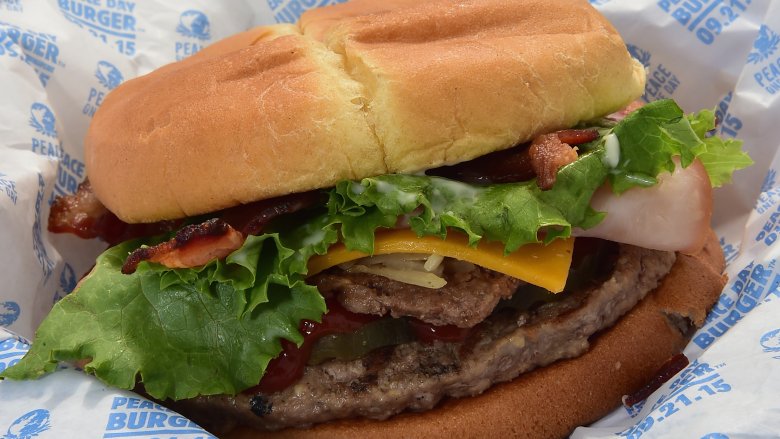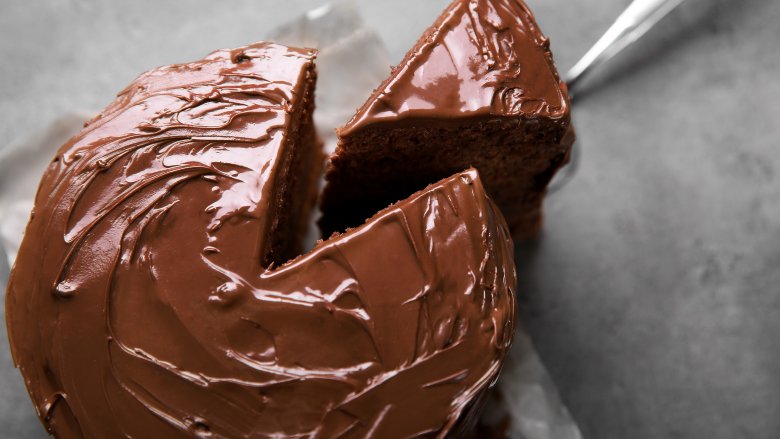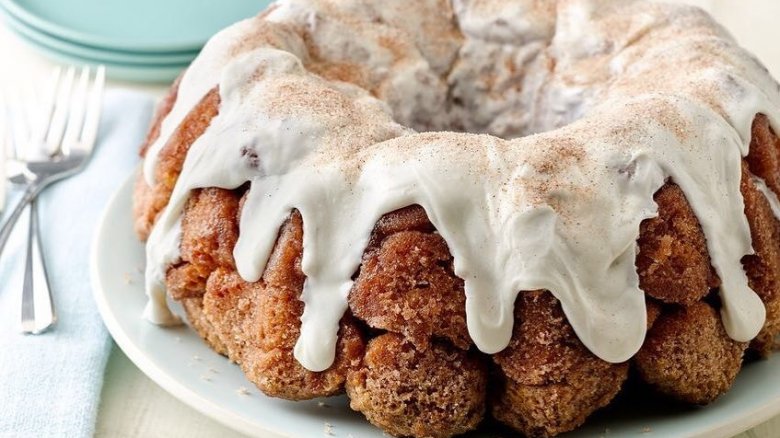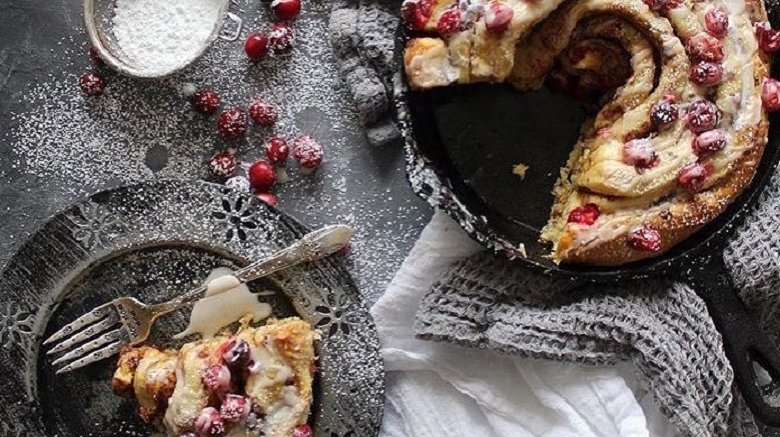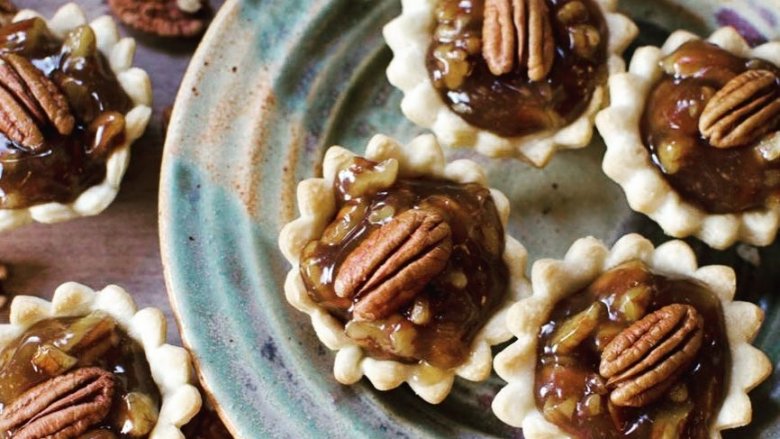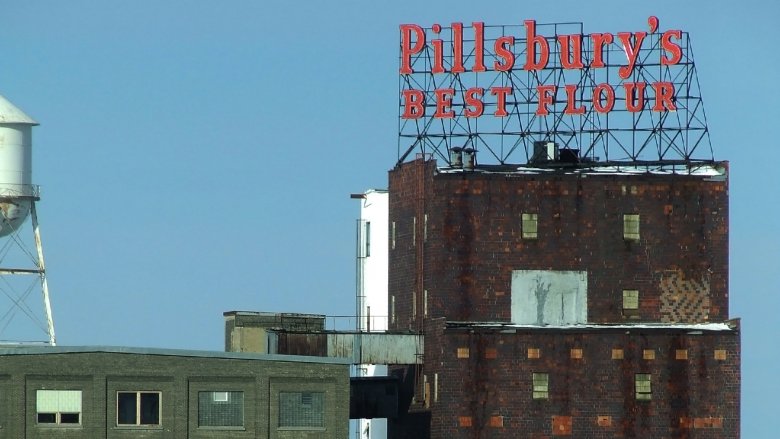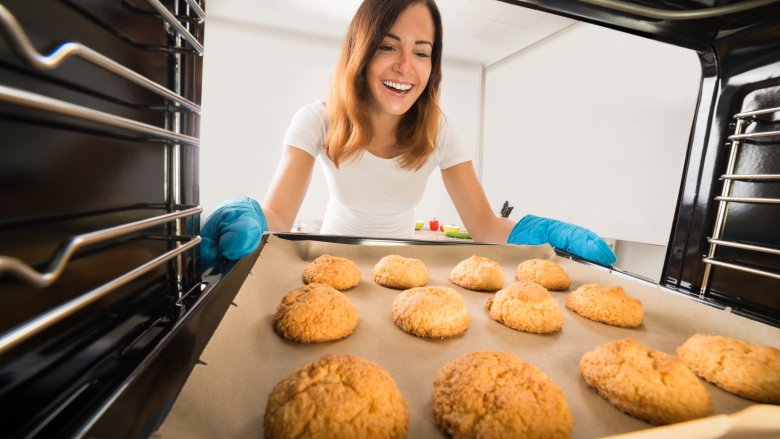The Untold Truth Of Pillsbury
No matter how committed to baking you are, you have to admit there's just something about that familiar pop and those flaky, buttery, Pillsbury biscuits. It might be the memories of having them served up with every special meal when you were a kid, or it might be the memory of getting home after school to the smell of fresh-baked Pillsbury cookies... or of making them yourself. Pillsbury products were the first thing many of us baked, and those smells and tastes are the things that stick with us. But how much do you really know about Pillsbury?
The doughboy has an actual name and a family
Pillsbury has done such a good job with its marketing that chances are, you think of the Pillsbury Doughboy before you even think of any of their actual products. But did you know he has an actual name, and so do his family members? According to official Pillsbury lore, the Doughboy's name is actually Poppin' Fresh. He made his debut in 1965, and in 1972, Pillsbury released a 7-inch-tall doll. He was so popular, the rest of his doll-family joined him starting in 1973. That included Poppie Fresh (officially designated as his "companion"), a son named Popper, a daughter named Bun-Bun, a set of grandparents called Granmommer and Granpopper, an Uncle Rollie, and two pets: Flapjack the dog and Biscuit the cat.
He was originally Claymation, and had a familiar voice
Poppin' Fresh's first commercial hit television screens on November 7, 1965. He already had his trademark giggle, and from that very first commercial until 1992, he was created with stop-action motion technology, also called Claymation. (That first model you see in the commercial above was made from five different bodies, 15 different heads, and cost a shocking $16,000.) Pillsbury had a few worries from the start, and one was that he would look too much like another iconic character: Casper the friendly ghost. A designer from Disney pitched in to create his iconic look, but he still needed a voice.
Pillsbury had more than 50 voice actors to choose from, and there were some big names there. One was Paul Winchell — you know him as Winnie the Pooh's Tigger. That'd be weird, right? It's no weirder than their actual choice: the first Poppin' Fresh was none other than Paul Frees — and you know him as Boris Badeov from The Adventures of Rocky and Bullwinkle. And his first co-star? That's Maureen McCormick, who would go on to star in The Brady Bunch.
They're not afraid to sue
Every company is protective of their intellectual property, but Pillsbury takes it to a whole new level. In 1984, they tried to step on a young, up-and-coming company called Ben & Jerry's by refusing to sell their Haagen-Dazs ice cream to any store that also sold Ben & Jerry's. That didn't work out for them, but that's not the only time they tried to step on the little guy.
In 2010, a Salt Lake Cookie company called My Dough Girl got a cease and desist letter from Pillsbury, insisting that she change her name. Tami Cromar had released her take-and-bake frozen cookies under a name that was a little too close to home for Pillsbury, and she had no choice but to swap names. And in 2017, Doughboy's Bake Shoppe got a similar letter from Pillsbury, and they were forced to re-do all their merchandising at a cost of about $10,000 — a catastrophic expense for a small business.
They used to make Whoppers
The sales, mergers, and acquisitions that go on behind the closed doors of the world's most popular brands can be a strange thing sometimes, and in 1967, Pillsbury made a weird move: they bought Burger King for $18 million.
It was under Pillsbury's ownership that Burger King expanded into the fast food giant it is today, and by the end of the 1970s they had turned it into the nation's second-largest burger chain. They're the ones that pitted Burger King against McDonald's, introduced the Burger King mascot, and started the so-called Burger Wars. Burger King continued to grow, but the loss of a few key players in the Burger Wars meant business started to decline. Pillsbury sold the chain in October 1988 to a British company called Grand Metropolitan, turning their $18 million purchase into a $5.2 billion sale.
Pillsbury doesn't actually produce all their dessert products
When you get a Pillsbury product, you expect it to be made by Pillsbury. But that's not actually the case with some of their branded items. In fact, if you buy any of their baking products, you're actually buying something made by Smucker.
Smucker — of the jelly and jam fame — bought the baking division of Pillsbury in 2004. That includes things like their cake mixes and other dessert-type products, and the acquisition hasn't always been profitable for them. In 2014, they announced sales were on the decline, and TheStreet suggested it might have something to do with the fact that their cake mixes got smaller. Pillsbury — along with Duncan Hines and Betty Crocker — changed their 18.25-ounce boxes to 15.25 ounces. They raised the price at the same time, a move that stemmed from rising product costs. You're getting less product for more money, and no one's happy about that.
Pillsbury does continue to make its other products — like biscuits — while operating under the umbrella of General Mills.
The Pillsbury Bake-Off had far-reaching effects
In 1949, Pillsbury launched the Grand National Recipe and Baking Contest, but the name that stuck was one coined by the media: the Bake-Off. It was created to mark Pillsbury's 80th birthday, and it was so successful they kept it going. Cooks and bakers were invited to submit their best recipes for a chance at winning a massive prize. The first winning recipe was submitted by Theodora Smafield, and it earned her a $50,000 grand prize. And, just as cool, her winning recipe is still on the Pillsbury website: you can make it here.
You probably don't know it, but the Pillsbury Bake-Off set the stage for the high-stakes cooking competitions that are so popular today. There was no such thing before, and it shaped the way we think about competitive cooking.
The Bake-Off also helped define food trends throughout the decades. When the 1966 winner used an obscure tool called a Bundt pan, its popularity soared so high that Pillsbury added a product line just for Bundt pan fans. Casseroles and savory, lasagna-like dishes were hot in the 60s, healthier options started showing up in the 1970s, and in the 2010s? Pumpkin spice.
Everyone said they'd fail
The man who gave his name to Pillsbury was Charles Alfred Pillsbury, and he was born in New Hampshire in 1842. In 1869, he moved to Minneapolis to join his uncle (a future Minnesota governor) in a business venture that, at the time, was viewed as a pretty dumb idea.
Backed by his father and uncle, Pillsbury bought a one-third share in a failing flour mill. At the time, the entire market was volatile, unstable, and unpredictable. Add in the fact that Pillsbury had absolutely no experience running or working in a mill, and it seemed destined to fail. But Pillsbury was a businessman, and he upgraded the mill's technology to guarantee he would turn a profit his first year in business, and he did. He also built the largest mill in the world by 1882, and it still stands on the banks of the Mississippi.
He introduced one of the country's first profit-sharing programs
It wasn't long before his mills were cranking out 20,000 barrels of flour each day, and with that new success came a need for more employees. Pillsbury knew happy employees were the key to further success, and he introduced the country's first profit-sharing program... and it's one you'd be thrilled to be a part of today.
He started the program in 1883, and at the time, an average annual salary was around $200. But by 1893, Pillsbury had distributed a whopping $150,000 to his employees, including $25,000 in a single year. That's the kind of money that changes lives, and he did it all alongside other endeavors, like pushing for all of Minneapolis to be wired for electricity and the establishment of a streetcar system.
Their product lines started with massive barrels of flour
In Pillsbury's early days, their fortune was built on selling massive quantities of flour packaged in either 196-pound barrels or 98-pound sacks. In 1875, they trademarked Pillsbury's Best XXXX, and by the 1890s, they were adding other types of flour to their product line. That included a "wheat breakfast food" called Vitos, a "Flaked Oat Food", and Germos, which was advertised as a "health flour" that was not only good for the brain, muscles, and digestive system, but it was supposed to counteract the "bad effects of ordinary white flour".
It was Vitos that became Pillsbury's money-maker, advertised as a "sterilized" food that consumers didn't have to worry about examining or throwing away, and as the perfect "All Round Food," good for making breakfast mushes or for replacing bread crumbs in other meals. As unappetizing as mush for breakfast sounds, it was so successful it opened the door for Pillsbury to start expanding their breakfast line. When the company reorganized in 1909, it did so with a focus on products like Vitos. Housewives became their target market, and Pillsbury — with their "Pillsbury's family of foods" — started becoming the company we know today.
They invented the idea of the energy bar
In the 1970s, NASA was making extraterrestrial progress in leaps and bounds. When they were hashing out the logistics of feeding astronauts on space stations and long missions, they turned to Pillsbury for help in creating a compact, nutritious, "food bar" that wouldn't take up much space on the shuttle. The result was Space Food Sticks, a 300-calorie bar packed full of carbohydrates, protein, and fat. They were the original energy bar, and in 1973 they were sent to Skylab. The official NASA press release sang the praises of Space Food Sticks, saying the astronauts were going to be treated to one on every third day of the mission.
It wasn't long after their development that funding for the US Space Program was cut, but Pillsbury wasn't about to let a good idea go to waste. They rebranded their product as the rather odd-sounding Food Sticks, and they were released for civilian consumption. A decline in the public opinion about the space program meant a decline in the popularity of Food Sticks, but they were brought back — briefly — in the 2000s by a non-Pillsbury company who acquired the trademarks.
They were behind the controversial Funny Face drink mixes
Everyone has their own feelings on political correctness, but whether you think the world has gone too far or not far enough, there are some things that are just cringeworthy. The last place you might expect to find anything offensive is in kids' drinks, but Pillsbury found themselves flooded with complaints way back in the late 1960s, not long after their Funny Face drink mixes were released.
Along with flavors like Rootin' Tootin' Raspberry were the definitely offensive Chinese Cherry and Injun Orange. Check out the video to see just how Pillsbury's ad agency decided to portray those particular characters, and you'll see why political correctness isn't necessarily a bad thing. In 1966, a Pillsbury spokesman told The New York Times, "We admit guilt all over the lot. It was in poor taste. We quickly saw our fault."
That wasn't the only problem with the mixes, either. In 1968, the FDA banned one of their key ingredients: Cyclamate. They took their drink mixes back to the drawing board again, returned with sugar, but couldn't compete with Kool-Aid.
They invented the worldwide standard for food safety
It wasn't long ago that finding contaminants, foreign matter, or spoilage was a normal sort of adventure that happened every time you opened something you bought at the store. That's the stuff of media headlines today, and you can thank Pillsbury for changing the rules on food safety.
In the 1960s, Pillsbury was the subject of a massive food recall for a product called Farina. Consumers were finding pieces of glass in the cereal they had bought for their infants, and as you can imagine, that was a big deal. A Pillsbury microbiologist named Howard Baumann (who had also been involved with Pillsbury's partnership with NASA), started campaigning for the development and implementation of a food safety program. That became the Hazard Analysis and Critical Control Points (HACCP), which outlined things like factory level risks and hazards. It was so successful that when it was presented at a national food safety conference, the FDA asked Pillsbury to put together a program to teach the FDA's own food inspectors. Today, it's used by everyone from the FDA to the UN's World Health Organization (WHO) and the Food and Agricultural Organization (FAO).
